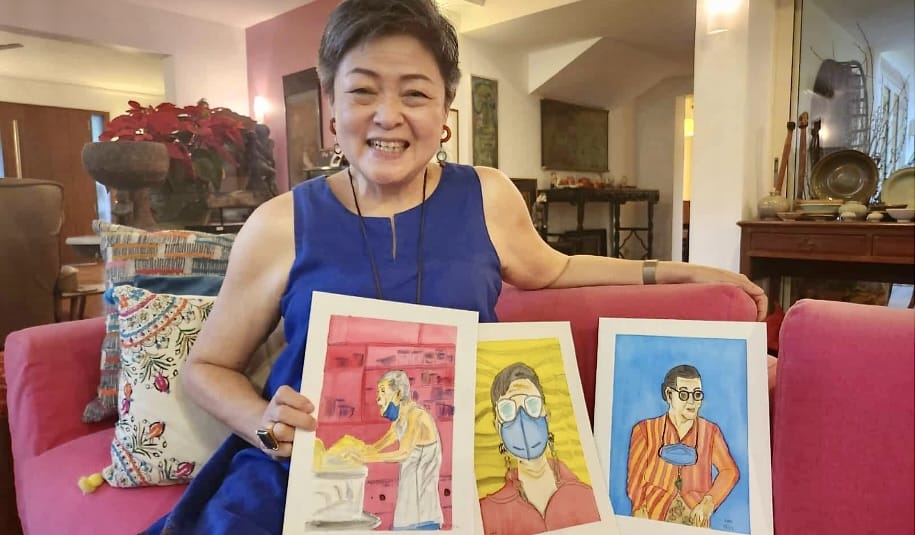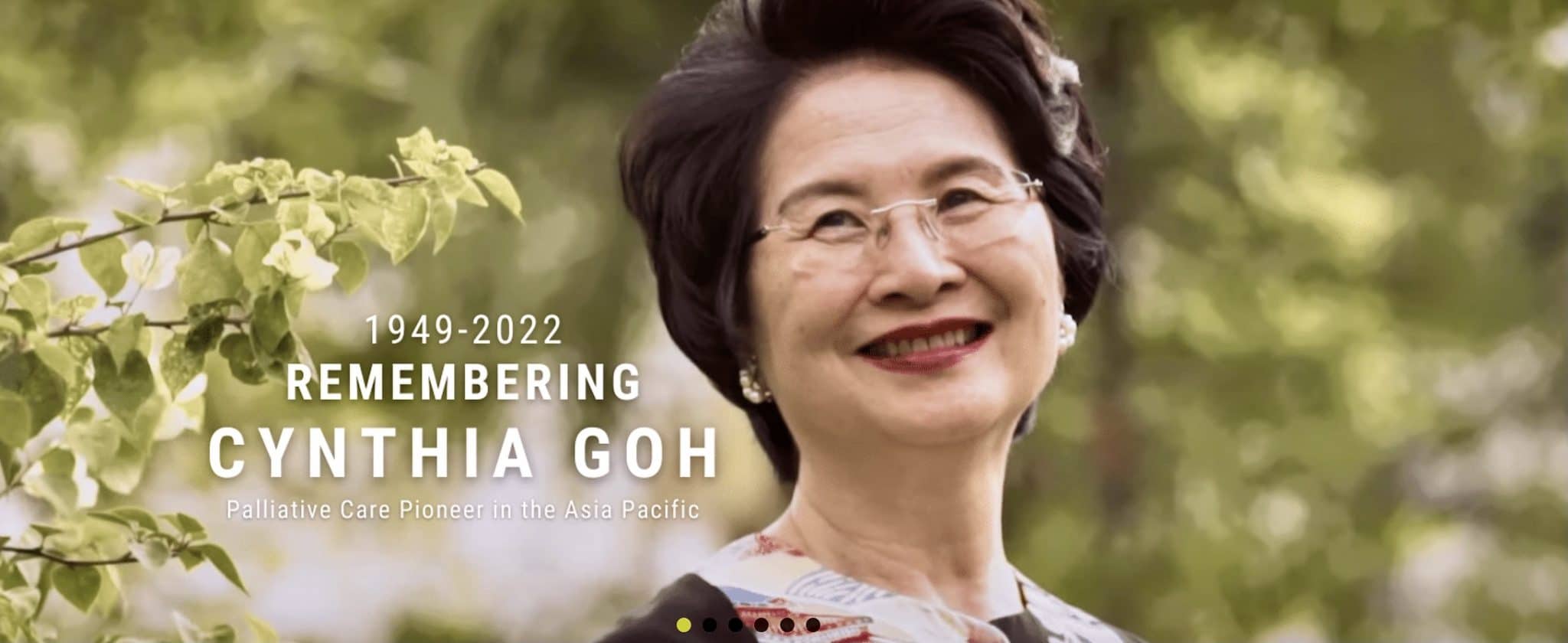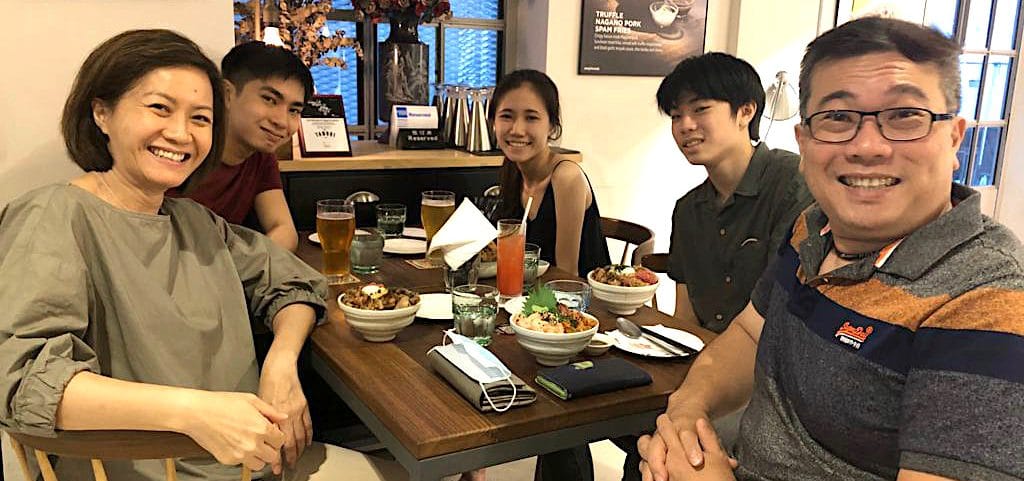“It was a miracle”: Dr Cynthia Goh on the chain of goodness that led Bangladeshi worker home
by Juleen Shaw // June 5, 2020, 5:23 pm
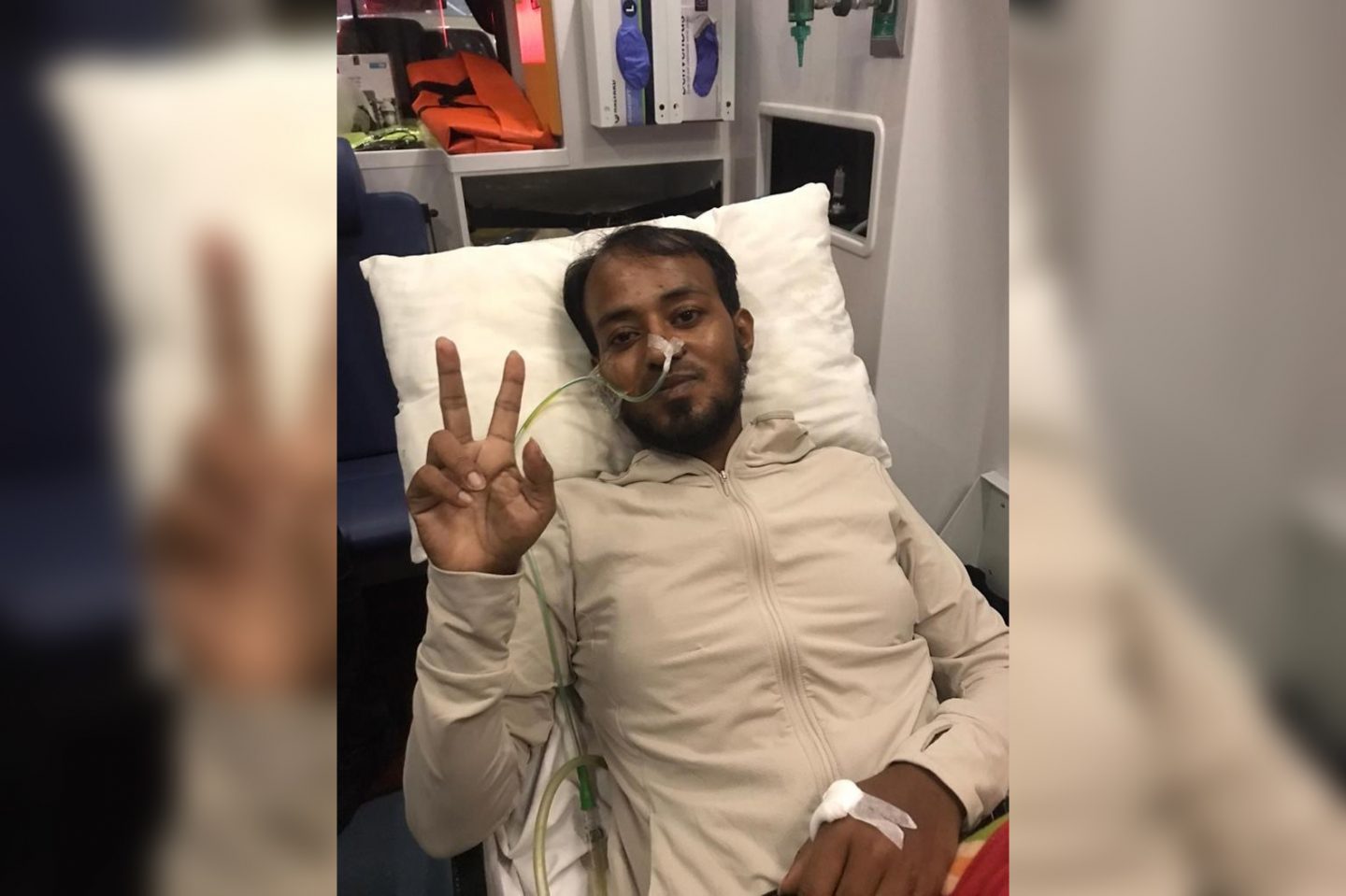
"Sikdar wanted you to have this photo," Dr Goh was told. It is of Mr Sikdar Rana in the ambulance on the way to the plane that would take him home for what was likely his last Eid. It is also the only photo Dr Goh has of him smiling. All photos courtesy of Dr Cynthia Goh unless otherwise stated.
“It only took one cog in the whole chain of events to not work, and the whole thing would not have worked,” Dr Cynthia Goh told Salt&Light, her voice tinged with wonder. “To me, that was a miracle.”
Dr Goh, 70, was one of a group of Singaporeans who had worked tirelessly to arrange a special flight to grant Bangladeshi shipyard worker, Sikdar Rana, his dying wish to return home for what was likely his last Eid with his family.
Diagnosed with advanced stomach cancer at the Singapore General Hospital (SGH) last month, Mr Rana, 34, had lost all hope but one – to see his six-year-old son again.
“Never have we come across a case like this,” said Dr Goh, who has seen “many touching stories of God’s provision”.
He was initially due to fly home to his hometown of Dhaka, Bangladesh, on May 19, but when the lockdown in Bangladesh was extended to May 30, all flights until the end of the month were cancelled.
With his condition rapidly deteriorating, Dr Goh, a senior consultant from the supportive and palliative care division at the National Cancer Centre Singapore, and her team, were worried that he might not make it home in time.
But in a remarkable series of events which “was unfolding in hours”, Dr Goh, who was working on the case while recovering from a broken hip, saw Mr Rana reunited with his family on May 22.
It had taken less than a week from the time Dr Goh took up Mr Rana’s case to the time he touched down in Bangladesh where he was received by his family.
“Never have we come across a case like this,” said Dr Goh, who has seen “many touching stories of God’s provision” in decades of work in palliative medicine.
With Circuit Breaker in place, the entire chain of events took place almost exclusively onscreen – through phones and computers. To this day, some of the key people in the whole episode have not met face to face.
A father’s dying wish
The odds were stacked against them from the start.
Dr Goh, who chairs the Asia Pacific Hospice Palliative Care Network (APHN), first came to know of Mr Rana on Friday, May 15, when her team consulted her on his care in Bangladesh after his scheduled repatriation on May 19.
On Monday, they heard that the lockdown in Bangladesh had been extended to May 30 and his May 19 flight was cancelled.
A check with the Ministry of Manpower revealed that the next flight to Bangladesh was on June 10. But with Mr Rana’s condition deteriorating rapidly, they knew that time was of the essence. This had become a life and death issue.
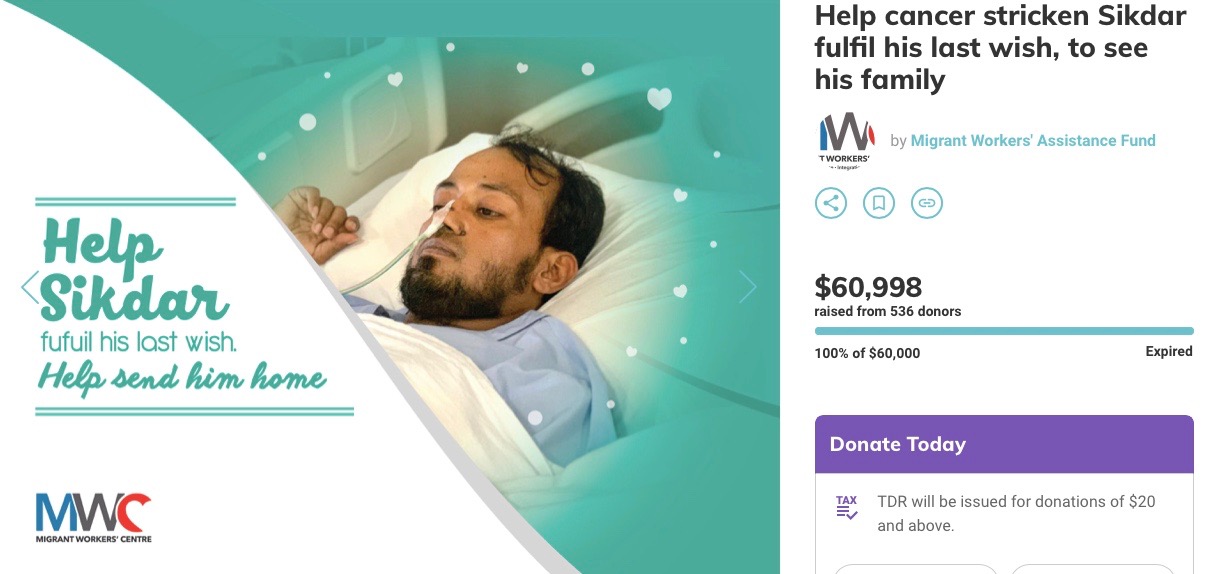
Singaporeans rallied to donate more than $60,000 in 72 hours so that Mr Rana could reunite with his family before it was too late. Photo from giving.sg.
“My team in SGH who knew him was absolutely distraught,” said Dr Goh. “We had been building up to this hope that we’d get him back home to his family. And it seemed as though all hope was dashed.”
Mr Rana had received one blow after another.
“He found hope in thinking about getting back to see his son.”
“This man was really devastated when he heard that, one, at the age of 34 he had cancer. Secondly, his operation revealed that the cancer couldn’t be cured. When the surgeons went in, they found that there was cancer everywhere. His whole stomach was encased in it.”
An oncologist was brought in but the prognosis was grim: Mr Rana was unlikely to survive chemotherapy.
“When my team saw him, he said, I just want to die. He asked about euthanasia,” said Dr Goh.
“In a situation like this, we try to establish different kinds of hope for the patients: Is their hope in prolongation of life? Better quality of life? Not having any pain?”
The team explored the options with Mr Rana and made a discovery: “He found hope in thinking about getting back to see his son. That was what his hope was hinged on.”
But when his flight was cancelled, the team was aghast. Would another hope of his be dashed?
Singaporeans rally
“How do we support him? Was there any way we could get him home?” Dr Goh’s team was “scrambling around to see what we could do”.
One of the nurses suggested crowdfunding to hire a medical evacuation plane.
With Circuit Breaker in place, the entire chain of events took place almost exclusively onscreen – through phones and computers.
A bemused Dr Goh replied: “We have no clue how to do this. Don’t even know where to start! This is not our field!”
By Wednesday, however, she decided that if she didn’t know how to get this going, she would find someone who did.
Calling up her fellow Assisi Hospice Board member, Anita Fam, who is also President of the National Council of Social Service, the wheels started flying.
Ms Fam immediately texted her former KhattarWong colleague, Dipa Swaminathan of It’s Raining Raincoats, who then contacted Senior Minister of State, Sim Ann, who introduced them to Chairman of Migrant Workers’ Centre (MWC), Yeo Guat Kwang. MWC is familiar with the Bangladesh High Commission, and MWC Executive Director, Bernard Menon, too, was pulled into the picture. Texts flew like wildfire under the chat group: “Patient Mr S.”
“There were many obstacles. The closed airspace, the cost, whether he was well enough to even fly.”
The cheapest option for a medical evacuation flight, by Hope Medflight Asia, cost $48,000, even after a subsidy by ST Aerospace. Crowdsourcing had to begin without delay.
Ms Fam and Mr Yeo undertook to underwrite the $60,000 that MWC recommended raising. Any funds left over from the flight would be given to Mr Rana’s family.
“It seemed almost impossible,” said Dr Goh who was watching the sequence of events unfold in a matter of hours. “It seemed unthinkable that we could even have him sent back.”
“There were many, many, many obstacles,” agreed Ms Fam. “The closed airspace, the cost, whether he was well enough to even fly because time wasn’t on his side.”
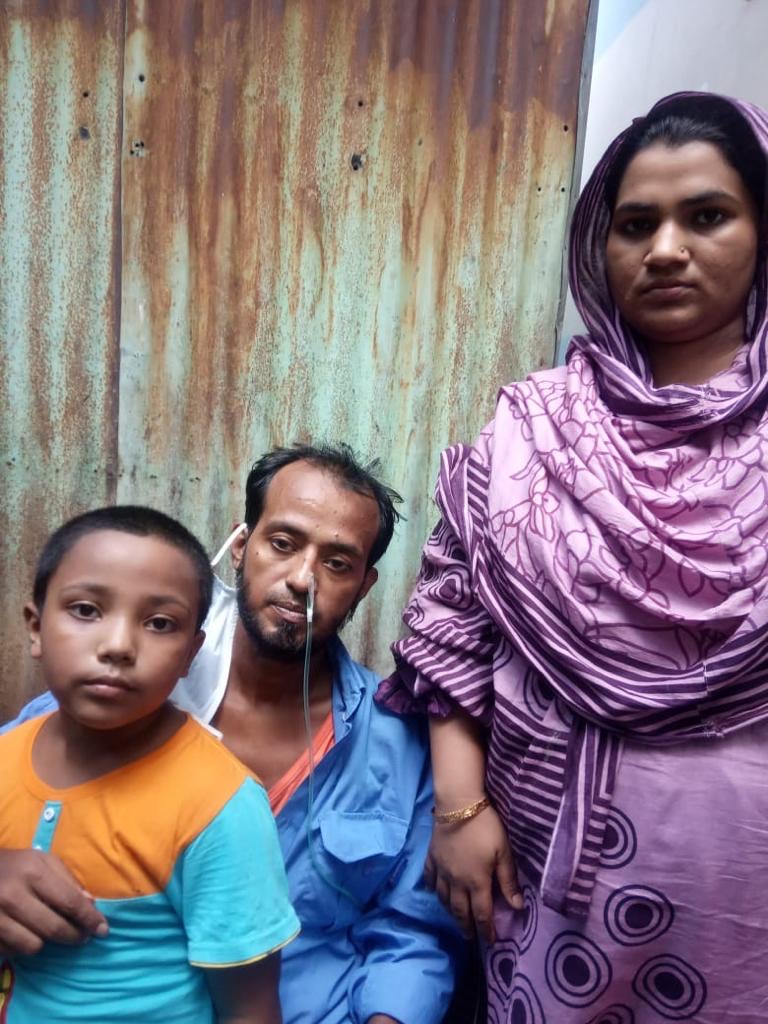
Mr Rana, reunited with his wife, Mousumi Akhter, and six-year-old son.
MWC quickly set up a crowdsourcing page on giving.sg under The Migrant Workers’ Assistance Fund (MWAF), the humanitarian charity of the Migrant Workers’ Centre (MWC).
Mr Rana’s compelling story moved Singaporeans so greatly that, within 72 hours, $60,998 was raised.
Home for Eid
But there was still the matter of the closed Bangladeshi airspace.
The flight that had been arranged by Dr Charles Johnson, Hope Medflight Asia’s medical director and flight physician, was scheduled for 9pm, Friday, May 22.
Application after application had to be filled, not least to certify the pilots COVID negative.
“How were we going to do this? We didn’t even know which country the pilots were flying in at the time,” said Dr Goh.
“Because of them I am with my son, and because of that, I can have a peaceful death.”
After a flurry of phone calls and texts and emails to authorities, Bangladesh agreed to waive the certification as the pilots would not even disembark the plane on the tarmac. Mr Rana himself had been certified COVID negative.
Dr Goh called in every contact she had in Bangladesh, where for years she had taught palliative medicine in four hospitals, and “I don’t know what they did – the Bangladesh side was also working furiously – and by 6.30pm on Friday evening (the very evening of the flight), we got word that Bangladesh was going to give its approval for landing”.
It was all the more remarkable for the fact that Friday is a weekend in Bangladesh, and this was also a special Friday – it ushered in the end of Ramadan and the start of Hari Raya Aidilfitri.
Dr Charles instructed Dr Goh to prepare the patient for transfer at 8.50pm.
In anticipation of the approval, he had prepared the plane and had sent an ambulance to SGH. The ambulance crew were sitting in the ambulance, and “the minute we heard we had landing permission, they loaded up the patient in the ambulance, drove to Seletar Air Base and the plane took off shortly after 9pm”.
Mr Rana arrived home just in time to mark Hari Raya Aidilfitri in his hometown of Dhaka.
Speaking through an interpreter for The Straits Times, he said: “This is probably my last Eid. After a long time, I am finally able to get a taste of my mother’s food. It feels like I’m in heaven. I don’t know how many people were involved in helping me, but from the bottom of my heart, I thank each and every person.
“Because of them I am with my son, and because of that, I can have a peaceful death.”
Each step of faith
It doesn’t end there. An SGH doctor from Kerala who could speak to Mr Rana in Hindi, heard that his son had told the father: “I sent you to buy toys but you became sick there.”
The father had teared at the thought of failing his son.
Upon hearing this, the SGH team who had looked after Mr Rana gathered some toys for him to take home to his son.
“What an amazing journey it’s been to see and experience a village of good and kind-hearted people who went the extra mile for this gentleman who is now home with his family,” said Ms Fam in a Facebook post on May 25.
To her and Dr Goh, there is no doubt that the hand of God was involved.
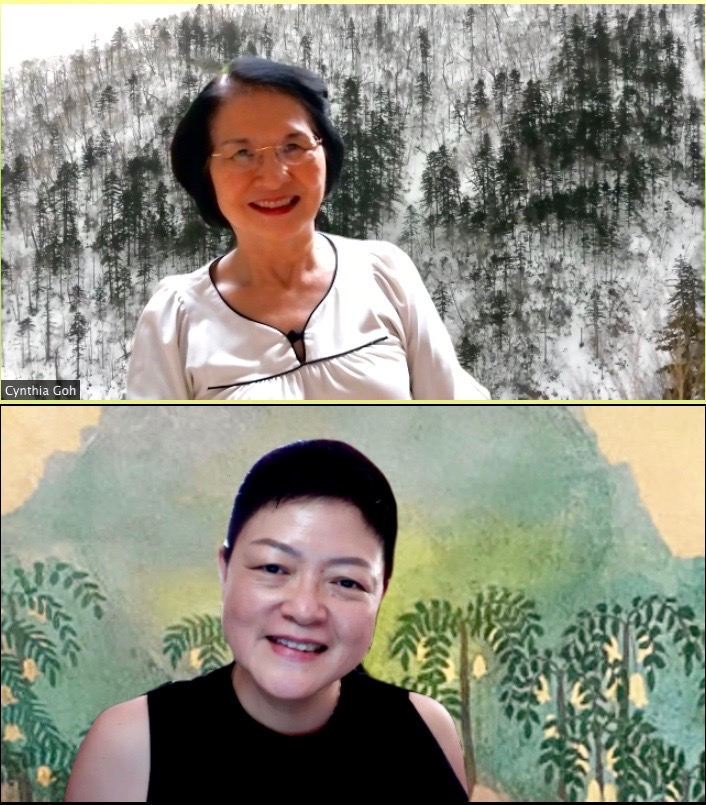
Dr Cynthia Goh (top) and Ms Anita Fam (below) in a Zoom interview with Salt&Light.
First of all, while most people would have chafed at being laid up with a broken hip, the busy doctor realised that her curtailed activity allowed her to concentrate fully on getting Mr Rana home.
“This is divine downtime for you, Cynthia,” said Ms Fam with a laugh, telling Salt&Light in an aside, “You wouldn’t believe how busy she normally is, flying all over. And yet she is always there for her patients.”
“Talk about being grounded,” Dr Goh agreed, laughing. “Not only are the planes grounded now, I am grounded too! So I could just throw myself into this thing and be tapping on my phone!”
“The fact that you’ve stood beside them and they haven’t been alone in their struggles. That’s what matters.”
Don’t believe her if she says “I didn’t have any other things to do”, though. The indefatigable doctor was chairing exco APHN meetings and conducting fireside chats with doctors over Zoom from her hospital bed after her hip replacement surgery.
Dr Goh, who had started at St Joseph’s Home, was President of HCA Hospice Care, and is often credited for establishing palliative medicine in Singapore, was bemused when asked what drove her to take on Mr Rana’s case.
“This is something that we do every day in palliative care,” she said. “We deal with life and death and people in very stricken circumstances. Our job is to help them find as holistic a solution as possible, because we don’t just look at: Can I fix the pain, can I fix the vomiting. We try to get the big picture, to say: What is important to this person?”
Ms Fam, who chairs the Board of Directors of Assisi Hospice, added: “That’s the philosophy of palliative care. It’s to do anything that one can, so that the patient can go as peacefully as they can, knowing that as much as possible was done. In a way, Mr Rana’s case is really the core of palliative care.”
“We often don’t get perfect results,” added Dr Goh. “And we are prepared for that. But very often, for the patients, it’s not the actual result that matters, it is having tried. The fact that you’ve stood beside them and they haven’t been alone in their struggles. That’s what matters.”
Her philosophy of care goes back to her first day as a medical student.
“Every step of the way was a step in faith. And God just coughed up the resources!”
“I remember the first day I walked into medical school, the student health officer, a GP, gave a lecture and then he said, ‘I want you to ask yourself: What makes a good doctor?’
“This was a question I asked myself from that first day as a medical student and I still do today. Of course a good doctor needs to be skilful, up to date and competent. But it’s more than that. We need to know who the patient is, what matters to him, what is his life like?
“These are the standards I hope will continue to permeate through our palliative care service throughout Singapore. We started HCA after St Joseph’s because the sisters said, ‘We think hospice care is too important for it to be associated with a particular religion. You need to start a secular association so that it can reach the whole of the Singapore population’.
“There were so many touching stories in our journey of setting up HCA. God provided for all we did. The HCA story is absolutely amazing. Every step of the way was a step in faith. And God just coughed up the resources!
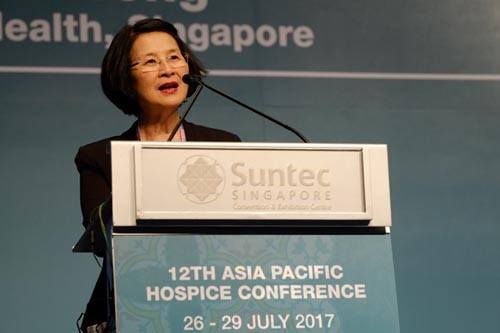
Dr Cynthia Goh welcoming delegates to the 12th Asia Pacific Hospice Conference 2017. Photo from the Singapore Hospice Council on Facebook.
“Even when we wanted to build the new hospice for Assisi – how did we think we’d be able to raise those funds? We couldn’t. But we knew that if this was something that God intended, then it would happen. And I was also very content that if this was something that God hadn’t intended, it shouldn’t happen. We should never pull ahead and do our own thing.
“Where there’s tremendous suffering, Christ is always there.”
“For me, it’s all about Matthew 25:40: ‘The King will reply, ‘Truly I tell you, whatever you did for one of the least of these brothers and sisters of mine, you did for me.’
“This is something I’ve always found true in palliative care because we see so much suffering. And people very often say to me, ‘How do you cope with it? How do you do this all the time?’
“The secret is that I believe that where there’s tremendous suffering, particularly suffering that is not within our power to alleviate, Christ is always there. Because He has suffered, He knows what it’s like. It doesn’t matter whether that person is Christian or not, our being present for them is like the presence of Christ to them.”
Added Ms Fam: “God doesn’t discriminate in terms of who He loves and who He uses. This is what this experience with Mr Rana showed me. God doesn’t compartmentalise us into Christians and non-Christians. He loves and uses us all. It was His chain of goodness and kindness that we all saw and experienced. To Him be the glory.”
The face of Christ
Dr Goh is still caring for Mr Rana through telehealth, communicating with Mr Rana’s physician in Bangladesh.
“In the beginning he was able to enjoy the company of his family. And now he’s lying on the bed, too weak to communicate except for a couple of words,” said Dr Goh. “He is suffering greatly, but at least he is suffering at home with his family.
“They didn’t just hear about him being sick in Singapore and then suddenly he is gone. They actually see him suffering and this is very important for them in preparing for the loss.
“I have this very precious photograph of Mr Rana which was taken by Dr Charles in the ambulance. I haven’t shared it except once with a Christian friend,” she said quietly.
“I don’t know how Dr Charles got this photograph, but he sent it to me and said, ‘Sikdar wants you to have this.’ And, you know, it is the only photograph I have of him smiling.
“When I look at him, I see the face of Christ. That’s how I find meaning in my work.”
Editor’s note: Salt&Light understands that Mr Rana passed away in his hometown on June 9, four days after this story was published. May he rest in peace.
We are an independent, non-profit organisation that relies on the generosity of our readers, such as yourself, to continue serving the kingdom. Every dollar donated goes directly back into our editorial coverage.
Would you consider partnering with us in our kingdom work by supporting us financially, either as a one-off donation, or a recurring pledge?
Support Salt&Light